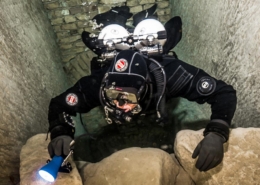my journey to becoming a CCR diver
Article by Dr Dubravka Vejnovic
Pictures by Mirko Bevenja
For someone who has been diving open circuit for ages, such as myself, switching to CCR diving was a huge leap! And not very pleasant at first. This is an honest story about the beginnings of my CCR training, and its goal is not to discourage you but to motivate you not to give up even if everything doesn’t go as you imagined.
Why switch from OC to CCR?
You know what they say: There is diving, and then there is CCR. For me, it was a natural continuation of my diving training. The moment I first learned about the rebreathers, I was sure I wanted to dive it. So, I worked hard towards that goal. I invested in my technical training and started saving money for the unit. As we all know, the major drawbacks of CCR diving are the starting costs: the training and the cost of the unit. But if you’re an avid diver, this will be an investment that will be recovered over time.
Here are some of the advantages of CCR diving: First of all, every diver’s dream: you can dive deeper and stay longer with greatly reduced deco time! Reduced size and weight are another one. After years of diving with a double tank, my back was immensely happy when I switched to rebreather! Then you get to enjoy breathing warm, moist air and forget all about that cotton mouth after dive feeling, even if you spend hours under water. Warm air will also reduce body heat loss. Gas efficiency was the biggest surprise for me, which also means spending less money on helium. Gas logistics are easier with CCR. Interesting wrecks and other dive spots are rarely easily accessible, nor are they near a dive shop. Gear needs to be transported to the dive site or hauled onto a boat. Often, multiple dives are required to fully experience a wreck or a cave. At last, but not least, you’ll enjoy no bubbles, silent diving, and a chance to get really close to wild-life. That way you can also dive in overhead environments without a risk of damaging it with air bubbles.
OK, now I’ve convinced you to go for CCR, but what to expect?
The bumpy learning curve
First of all, you have to choose the unit you want to dive and find a good, skilled (and patient haha!) instructor. For me, it was the easy part. I was already a member of TDI Triton Five Star Diving Center founded and led by Instuctor Trainer Mr Mirko Bevenja (Belgrade, Serbia). All the guys in Triton Tec Team were already using Poseidon Se7en and my instructor is also certified for servicing Poseidon equipment. When it comes to logistics, this is of the utmost importance – you would want to surround yourself with dive buddies who are familiar with your unit and who can help you if something gets broken or starts malfunctioning.
My first theory class was a nightmare. I had a feeling I did not get anything properly as there was loads of new information. I started having second thoughts about whether rebreather training was a good decision. My guess is that it is easier to learn rebreather diving if you haven’t spent so many years diving OC previously. After another theory class, I slowly regained my self-confidence. I got familiar with the new concept of diving, got to know my unit better, and learned about each part of it. And it was so light to carry compered to my doubles! In the following days TDI Diving Rebreathers Manual became my best friend and I just loved it. It’s one of the best diving textbooks I came across during my 15-year diving career. Since I’m a geek (and not ashamed to admit it!), I did my final exam with a 100% score.
Water practice was more challenging. You need to get used to the idea that breathing does not affect your buoyancy. The first dive went more or less smoothly, and I was thinking, what’s the big deal?! It turned out that I was so thrilled with my new experience that I wasn’t able to analyze all elements of the dive critically. In my head, I was already a CCR diver. In reality, I sucked! At that point, the instructor’s role is crucial. He or she has to be able to give honest feedback to a student, but not in a discouraging way. You need to realize you’re awful, but not lose faith that you will improve. I was determined to finish my training successfully, and I practiced hard. Giving up was not an option for me, even when I didn’t perform well. And I felt very grateful for the support from the instructor and team buddies.
Hours of practice are rewarded at the end!
It’s been two years since I did my first CCR dive. It completely changed how I perceived diving. I have done many wonderful dives since then that could not be done with OC. Even now, I practice each time I have a chance, since there is always room for improvement in skills. If you are very dedicated, focused, and self-critical, you will reach a point where you can feel fully relaxed and in control of your unit and start enjoying the benefits of CCR to the fullest. For me, it was a bumpy road, but it paid off in the end.
So, do not ask me why I dive CCR. Ask yourself why you don’t.













Tinggalkan balasan
Ingin bergabung dalam diskusi?Silahkan berkontribusi!